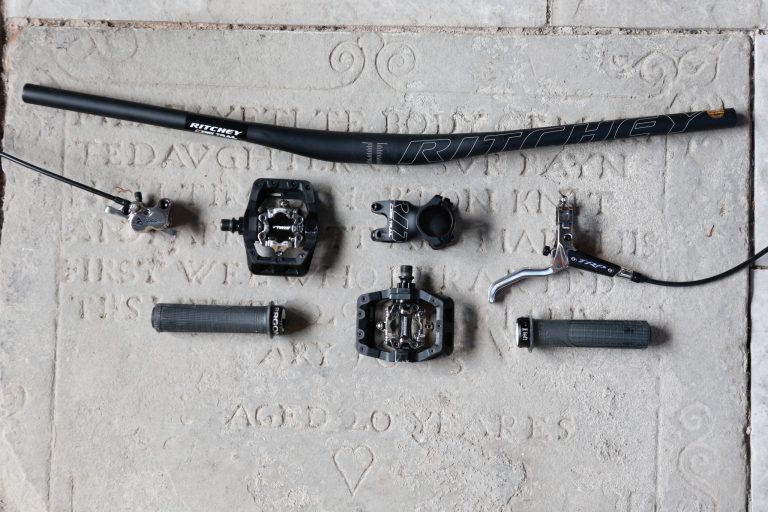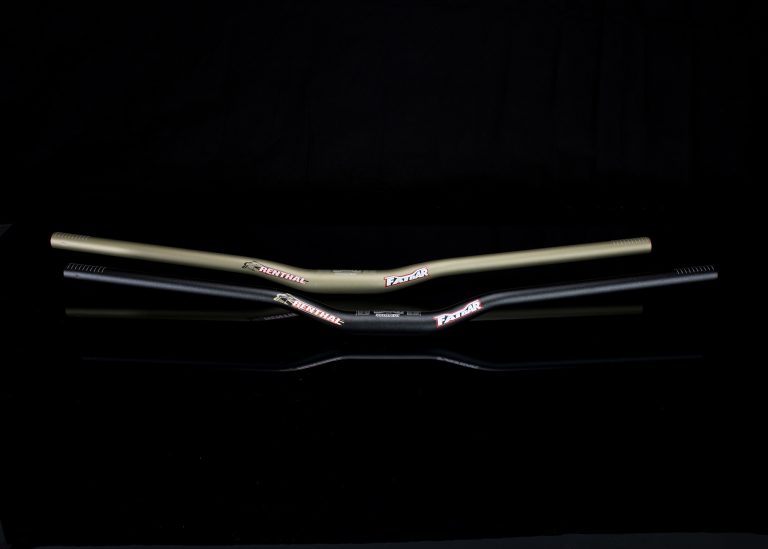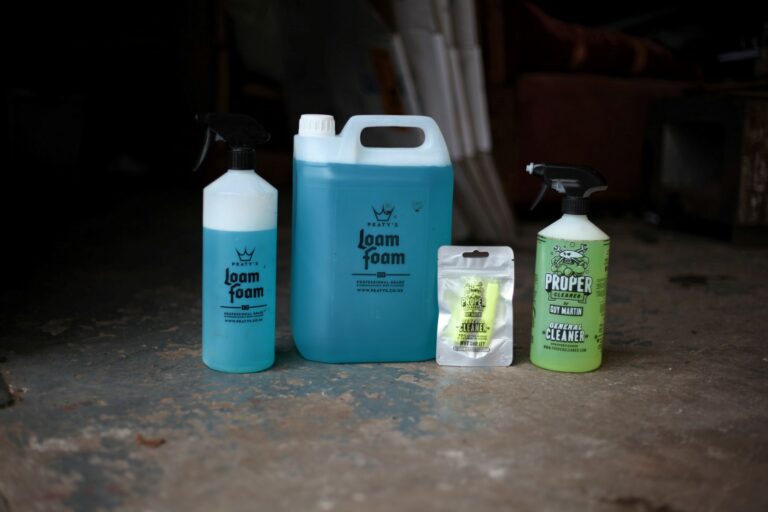
The geometry numbers on the Banshee are relatively straightforward by today’s 160mm standards…
WEIGHTS AND MEASURES (size large/neutral settings)| Wheel Size | 26″ | 27.5″ |
| Wheelbase | 46.5” | 46.9” |
| Headangle | 65.5º | 65.5º |
| Bottom Bracket | 13.65” | 14.6” |
| Chainstay | 16.8” | 17.2” |
| Front Centre | 29.3” | 29.7″ |
| Bar | 780mm | 780mm |
| Stem | 50mm | 50mm |
| Weight | 28.89lb | 30.27lb |
More than anything the geometry detail highlights a bike that doesn’t change that radically in its nature between wheels sizes. Similar in wheelbase and BB height as our much–loved 650 Rotwild and Norco Range in that respect.
In its 26” wheel mode the Banshee, like many other bikes, replicates the numbers as found on that master of everything, the Specialized Enduro. Tried and tested over almost a decade, 160mm geometry from most companies is now based around these numbers. The only difference being in suspension design, damper and compatibility, styling, weight, price and…ha, well that’s a fair bit then I guess.
On costs alone the Banshee stands its ground well, £1500 for the frameset isn’t too bad. It’s also a good option for many riders not in the market for complete bikes, which seem to be in abundance. I guess it’s when you start banging on £1500 plus for wheels and forks that things start mounting up, and the German direct sales brands take their slice as well in offering full build options. But hey, how many offer a bike that is as versatile as the Banshee that allows you to swap all your bits over?
Cane Creek manages the business of damping exceptionally well and up front the Banshee is graced with the bigger, stiffer 36 fork compared to the 34’s fitted to many 650B bikes (Norco, Rotwild, Cube). Why fit ‘smaller’ to a bike that goes faster? Plus there’s the 15mm over 20mm axles to consider. It was weird to later drop to a skinnier fork for what might be a faster bike with the bigger wheels.
The detail on the frame is OK but the Rune could certainly do with a spot of tidying up compared to many of the more polished offerings. Cabling is untidy. That said it offers that huge range of adjustment, with all the rear axle options from 135mm to 150mm.
DO THE RECOMMENDED SUSPENSION SETTINGS PROVIDE REASONABLE PERFORMANCE?It’s a pretty mild ask that a company should provide at least a base setting for the bikes they offer. Few do. In the case of the Banshee the bike is graced with an exceptional damper in the Cane Creek Double Barrel and a base set–up chart for the rear damper – remember you have to work it out for yourself up front.
Given the riding conditions this year and last it would probably be more worthwhile giving my ‘mind settings’ rather than how many clicks this way or that I’ve given a damper. The CCDB is an incredibly complex unit that requires many days on a variety of tracks to get anywhere near perfect. Even then, weather conditions will compromise a good setting for one particular track. In short though the base settings are a pretty good workable start point.
RIDE Whilst the 26” wheels offer a good performance bike I wanted a bit more, so I got the bike running on 650 pretty quickly. The Banshee offers all the angles and damping to see you through troubled waters. Even in the low setting with 650 wheels the Rune is not particularly squat, which might hint of a bike to pedal through carnage as well as glide. As a 160mm bike it’s weighted more towards the DH than XC side of the spectrum, more of an Specialized Enduro than an Ibis Mojo in nature. More of a tub than a Lapierre Spicy. But faster wheels remember.
Whilst the 26” wheels offer a good performance bike I wanted a bit more, so I got the bike running on 650 pretty quickly. The Banshee offers all the angles and damping to see you through troubled waters. Even in the low setting with 650 wheels the Rune is not particularly squat, which might hint of a bike to pedal through carnage as well as glide. As a 160mm bike it’s weighted more towards the DH than XC side of the spectrum, more of an Specialized Enduro than an Ibis Mojo in nature. More of a tub than a Lapierre Spicy. But faster wheels remember.
What of the performance then? Well, because of the nature of the suspension system/damper the bike is not able to fully utilize the higher BB height leaving a bike that is slightly laboured on power transfer to the rear wheel, it’s pretty good off the very top of the stroke compared to some other bikes, but (in 26” mode comparison) its certainly no Yeti SB66. That alone is not always a bad thing, for such bikes sometimes make up elsewhere. And its in high–speed situations that the Rune shows off its better side, for when there’s momentum the bike can be manoeuvred, able to use the ground far more effectively than in slow speed situations where it’s very difficult to generate instant lift. There’s a bit too much movement in the rear system and in the high speed stuff the bike was compromised slightly by the under power Fox 34 that is a touch out of its depth with this much travel with these size wheels.
The recommended settings are reasonable, certainly a workable base. But it can be made better with time, like I said, it was happy to chug along wheels on ground, but it needed life, a platform on which to push on from – a bit more speed in both directions would aid this. The biggest issue was the need to switch settings between the two wheel sizes. Cane Creek say the bike works better with the new XVOL can but we didn’t have the shock in time for this.
VERDICTNot bad. A bike that does actually ride pretty well in both 26” and 27.5” wheel sizes, the positive being that there’s less pressure to make the correct wheel size decision. In that respect this bike, as well as the Liteville featured elsewhere in the magazine, sit pretty comfortably. Yes it would be better had it been fine tuned for one wheel size or the other, but certainly as it stands a more than capable all round 160 bike that’s fun to ride.
 It can batter through tough terrain as good as any other 160mm bike, but that possibly makes it a tad one–dimensional compared to some lightweight 160mm offerings. The bigger wheels allow what is a big travel bike a bit more pace in–between sections, more speed on descents, more grip. Expect nearly all the top enduro racers to be dropping into Punta Alla for opening World enduro round with the 650 wheels.
It can batter through tough terrain as good as any other 160mm bike, but that possibly makes it a tad one–dimensional compared to some lightweight 160mm offerings. The bigger wheels allow what is a big travel bike a bit more pace in–between sections, more speed on descents, more grip. Expect nearly all the top enduro racers to be dropping into Punta Alla for opening World enduro round with the 650 wheels.
So would I go 26” or 650B? Put it this way, you’d be crazy not to run it in 650, the difference is so noticeable. An easy question and I’m no longer so worried about fork availability as it looks as there will be more 650 fork options very soon. My only concern is lack of mud tyres.
Compared to other 650’s? A bit more all–round than a Norco Range and with better damping than a Cube, but still needing to lose a bit of weight. Overall though a solid and rugged 160mm bike.
The Rune is available as frame only from £1489.99 with a Fox CTD and £1574.99 with a Cane Creek Double Barrel Air.
Contact www.ison-distribution.com





